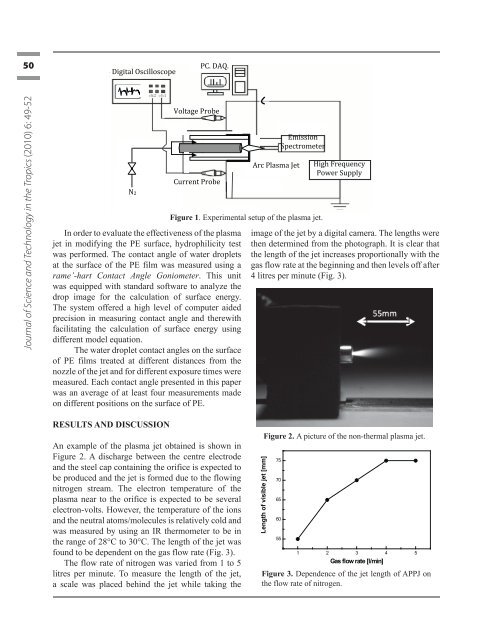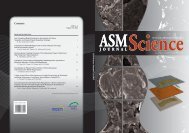Download - Akademi Sains Malaysia
Download - Akademi Sains Malaysia
Download - Akademi Sains Malaysia
Create successful ePaper yourself
Turn your PDF publications into a flip-book with our unique Google optimized e-Paper software.
50<br />
Journal of Science and Technology in the Tropics (2010) 6: 49-52<br />
<br />
Digital Oscilloscope <br />
N2 <br />
In order to evaluate the effectiveness of the plasma<br />
jet in modifying the PE surface, hydrophilicity test<br />
was performed. The contact angle of water droplets<br />
at the surface of the PE film was measured using a<br />
rame’-hart Contact Angle Goniometer. This unit<br />
was equipped with standard software to analyze the<br />
drop image for the calculation of surface energy.<br />
The system offered a high level of computer aided<br />
precision in measuring contact angle and therewith<br />
facilitating the calculation of surface energy using<br />
different model equation.<br />
The water droplet contact angles on the surface<br />
of PE films treated at different distances from the<br />
nozzle of the jet and for different exposure times were<br />
measured. Each contact angle presented in this paper<br />
was an average of at least four measurements made<br />
on different positions on the surface of PE.<br />
RESULTS AND DISCUSSION<br />
PC. DAQ. <br />
Voltage Probe <br />
Current Probe <br />
An example of the plasma jet obtained is shown in<br />
Figure 2. A discharge between the centre electrode<br />
and the steel cap containing the orifice is expected to<br />
be produced and the jet is formed due to the flowing<br />
nitrogen stream. The electron temperature of the<br />
plasma near to the orifice is expected to be several<br />
electron-volts. However, the temperature of the ions<br />
and the neutral atoms/molecules is relatively cold and<br />
was measured by using an IR thermometer to be in<br />
the range of 28°C to 30°C. The length of the jet was<br />
found to be dependent on the gas flow rate (Fig. 3).<br />
The flow rate of nitrogen was varied from 1 to 5<br />
litres per minute. To measure the length of the jet,<br />
a scale was placed behind the jet while taking the<br />
Arc Plasma Jet <br />
Emission <br />
Spectrometer <br />
Figure 1. Experimental setup of the plasma jet.<br />
Figure 1. Experimental setup of the plasma jet. <br />
High Frequency <br />
Power Supply <br />
image of the jet by a digital camera. The lengths were<br />
then determined from the photograph. It is clear that<br />
the length of the jet increases proportionally with the<br />
gas flow rate at the beginning and then levels off after<br />
4 litres per minute (Fig. 3).<br />
Length of visible jet [mm]<br />
Figure 2. A picture of the non-thermal plasma jet.<br />
75<br />
70<br />
65<br />
60<br />
55<br />
1 2 3 4 5<br />
Gas flow rate [l/min]<br />
Figure 3. Dependence of the jet length of APPJ on<br />
the flow rate of nitrogen.<br />
Jostt vol 6.indd 50 7/22/10 10:09:30 PM<br />
<br />

















